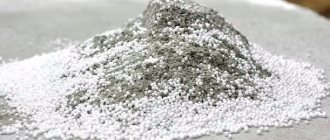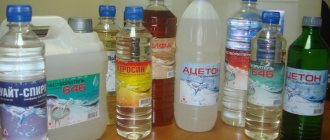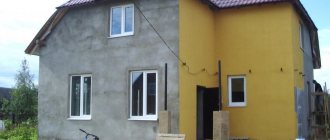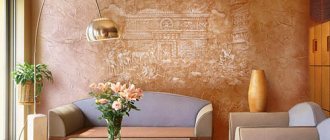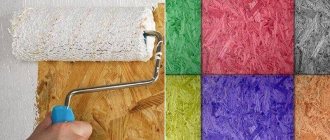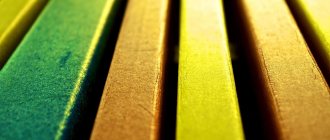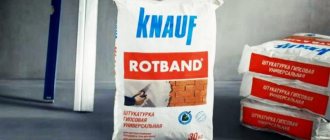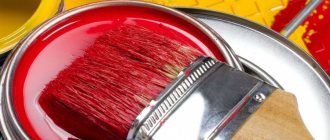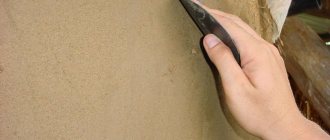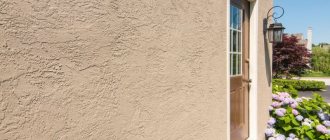Plastering internal and external walls is the most labor-intensive process, and it will be a shame if the work done goes down the drain. That is why the mixture for plastering walls plays a very important role. You can prepare building mixtures with your own hands. To do this, you will need to select the necessary ingredients, sift the sand, maintain all proportions and mix them with water until a homogeneous mass is obtained. This process takes a lot of time and the mixture for plastering walls may ultimately be of poor quality.
Mixture for plastering works
But, fortunately, manufacturers of mortars have thought about putting dry compositions for plastering on sale; your task is to choose the right composition for interior or exterior work.
Scope of use
The dry mixture differs from cement-sand mortar in the precise dosage of components and a varied base suitable for the specific operating conditions of the building. This expands its scope of application:
- reinforcement of thermal insulation boards using mesh;
- plastering of facades;
- sanitation and cosmetic work;
- leveling surfaces for finishing or coating;
- waterproofing foundations;
- pool lining;
- laying finishing tiles;
- installation of skirting boards and other decorative interior elements.
This is an incomplete list of activities in which dry construction mixtures are used. It is worth noting that a solution made from dry plaster is used depending on the type of base. Cement compositions are suitable for cladding facades and processing the plinth/foundation. Gypsum-based material is limited to interior work.
Which plaster is better for plastering walls?
When a renovation takes place in a room, sooner or later the question arises: “Which plaster is best for plastering the walls?” To understand this issue, it is necessary to find out the advantages and disadvantages of various types of plaster.
According to its purpose, plaster is divided into:
- simple - ordinary plaster, with which the walls are leveled for further gluing or painting;
- decorative - used as a finishing touch for walls; it can also level surfaces with small grooves, depressions, and irregularities;
- special - contains particles that change the properties of the mixture. Thus, when barite concentrate is added, the plaster becomes X-ray protective, and if liquid glass and quartzite are added, an acid-resistant mass can be obtained.
Simple plaster, in turn, is divided into several more types depending on the binder:
- cement and sand. The proportions of the main components may vary, depending on the purpose of applying the mass. It has a rough surface, so after drying, a layer of putty is applied to it;
- lime. It is easier to work with such plaster due to the plasticity of the mixture, so the time for applying plaster to the surface is significantly reduced. Cement is present in the mass in small quantities (up to 10%). This is reflected in the strength of the material;
- gypsum. Gypsum plaster does not have waterproof properties, so it is better not to use it in the bathroom. It dries out quite quickly. This property must be taken into account when choosing the amount of dry mixture for dilution with water.
Criterias of choice
Selection of plaster
On what basis?
The purpose is determined by the components of the composition.
Plaster
The main component is gypsum. In addition to it, various mineral additives are used to give the solution certain qualities. This species is characterized by low resistance to moisture and limited viability time. The treated surface is weakly resistant to mechanical stress. This narrows the scope of application of plaster, in contrast to cement and lime composition.
Among the advantages of the gypsum mixture: rapid hardening, no need for additional surface treatment, simple method of application. When working with the solution, common problems such as layer slipping are not observed. Characterized by high plasticity. It lays flat on the surface and does not shrink after hardening.
Cement
This is the most popular composition. The main function is performed by cement. Sand and other fillers give the solution elasticity and strength. This type is suitable for interior and exterior work.
Among the advantages: resistance to atmospheric factors and aggressive environments, durability. The plaster is easy to use and remains viable for a long time. The low cost of the material is considered a pleasant bonus.
When choosing a cement composition, it is important to take into account its disadvantages. It takes a long time to dry, which delays further installation. Putty must be applied over the plaster to smooth the surface. The solution distribution technique deserves special attention. Sometimes it’s impossible for a beginner to cope.
Limestone
The composition is based on lime and sand. Cement and other fillers can also be used to impart certain properties to the solution. Most often, lime plaster is used for interior work. But it is also used for the facade.
This type is characterized by relatively fast hardening and antibacterial properties. Other advantages include excellent adhesion, prevention of fungus and mold. The pricing policy is affordable.
When using the material, the following disadvantages should be taken into account: insufficient strength, low resistance to a humid environment.
Lime-cement plaster KREPS Extra-light, 25 kg
Cement-lime
This type is used for interior work in rooms with high humidity levels. The solution becomes less durable as the proportion of lime in the total volume of the composition increases. In addition, the hardening time of the plaster increases.
The cement-lime mixture is not recommended for application to painted surfaces, wooden parts, and plastic.
Mineral heat-resistant plaster TERRACOTTE 10 kg
Mineral
The composition includes small fragments of marble chips, granite, and lime. Light cement is also added. This combination gives the solution high decorative qualities. Mineral plaster adheres to the base more tightly than other types. It takes 1-2 days to dry, although already 20 minutes after application the mass hardens.
You should work quickly with the mineral mixture due to the short pot life of the solution. Apply it, forming an even layer without corrections.
Advantages: high resistance to microbiological processes, vapor permeability, heat and sound insulation qualities.
Polymer
When producing a dry mixture, resin copolymers (silicone, acrylic, siloxane), liquid potassium glass and other components are used to give the plaster elasticity and resistance to aggressive environments.
The polymer composition is used to treat surfaces and is used as the basis for decorative plaster, which includes crushed rock (granite, quartz, marble, etc. minerals). The product is distinguished by its high strength, good adhesion, and a wide selection of colors.
Polymer plaster is produced with different bases depending on the components of the composition (acrylic, silicone, silicate).
Silicate
Used mainly for outdoor work. The composition is characterized by high adhesion and hydrophobicity. It is convenient to work with the solution due to its elasticity. The surfaces are breathable, which is ensured by vapor permeability.
Advantages: no cracks after drying, uniform structure.
Plaster also has disadvantages: limited color options; before applying the solution, the surface must be treated with a special silicone-based primer; the cost cannot be called affordable.
Popular brands
In order not to be mistaken with quality, it is recommended to give preference to well-known brands. Large companies constantly improve their products, strictly adhere to the technological process, and use only certified raw materials. Among the popular brands: KNAUF, Perel, Ceresit, GLIMS, Unis, Kreps, Volma, Caparol, etc.
Grain size, mm
To produce each type of plaster mixture, certain raw materials with different particle fractions are used. The average grain size is 0.5-4.0 mm. In the mineral composition, large filler parameters are used (4.0-6.0 mm).
Minimum and maximum layer thickness, mm
The thickness of the plaster ball is determined by the grain fraction and the type of base. The functionality of the plaster is also taken into account.
Experts recommend not applying a solution less than 0.5 mm thick. A thin ball will not be strong enough. Due to minor mechanical loads, cracks and peeling occur.
The maximum value cannot exceed 2-2.5 cm (per application). If the thickness is insufficient, you can apply a second ball, but only after the previous layer has completely dried.
A popular type of cement-based plaster is applied in a layer of 5 to 40 mm. Using a gypsum composition, it is possible to form a ball up to 100 mm.
Application
Mixtures are produced for facades and interior works. Their compositions differ. Manufacturers indicate on the packaging the conditions for which the plaster is intended.
- For outdoor use, they are characterized by durability, strength and resistance to various influences (atmospheric, mechanical). The treated surface can withstand sudden temperature changes, frost, and ultraviolet radiation.
- The product for indoor use is environmentally friendly and has decorative qualities.
Regardless of the purpose, you need to choose the composition taking into account the type of base (wood, brick, concrete, etc.). The division based on the scope of application is a convention. In most cases, they are used for facades and indoors.
Types of plasters by composition
Plasters for interior wall decoration are distinguished by the composition of the included components.
| Name of putty | Characteristic |
| Silicate | It is used together with different surfaces because it has good vapor permeability and hydrophobicity. Liquid glass is the main substance in manufacturing, which provides elasticity, so that the coating does not crack. A good quality is that it is antistatic, so little dirt sticks to this surface. You can buy silicate mixture in liquid form. To work, you just need to stir the mixture. It is better for qualified specialists to use this material, since the putty must be applied very quickly. Before use, you also need to use a primer, this is a disadvantage because it will require extra costs. |
| Mineral | This is one of the popular and cheapest materials compared to others. Another name is polymer cement. Cement is the main substance. You can add various elements or colored chips, the price is much higher. Several advantages of this material: ease of application, good strength, high moisture resistance, does not burn. The disadvantages include poor ductility, which can lead to the formation of cracks on the outer and inner sides. In stores, you can most often see this plaster in the form of a white powder. For a colored interior, after plastering you need to paint it in any color. |
| Cement | Cement plaster mixture for interior work is moisture resistant. Therefore, it is used to level ceilings in rooms with high humidity: kitchen, bathroom, balcony. After drying it becomes white. Used for painting walls. This type has adhesion to aerated concrete surfaces. Not afraid of temperature changes. The material is applied using a spatula. Apply up to three layers. The thickness of the bottom layer does not exceed 0.7 mm. This figure is less than when plastering walls. You can buy it in dry form, a solution compared to ready-made, you need to mix it yourself. The prepared solution can be kept in the open air for more than three hours. It has one drawback - it is not elastic. |
| Plaster | It is used to treat ceilings or walls. Has environmental and safe characteristics. There is no vapor barrier foam. Apply in one layer, 60 mm thick. It can be purchased ready-made and does not require additional interventions. Universal, suitable for drywall and wood. Thanks to the fine grain, the surface is smooth, which can be painted or decorated with finishing. The universal type is used more often for apartment renovations and for painting walls. It is not moisture resistant, so it is not recommended to putty rooms like the bathroom or kitchen. Even a beginner can handle this material. |
| Polymer | This species contains polymeric substances. It comes in two types: latex and acrylic. Moisture resistant, suitable for rooms or premises. They are not afraid of temperature changes. Characterized by plasticity and odorlessness. Sold ready and dry. Expensive. Long shelf life. Instructions, method of use, concentration, proportions are indicated on the package. To work, you need a special tool - a power tool and a mixer attachment. With this type it is possible to putty the walls for painting yourself. Produced according to GOST. |
How to prepare the solution
The solution is prepared in accordance with the instructions, which are detailed on the package with the dry mixture. Most often, two recipe options are offered: per bag and per 1 kg of dry powder.
To do this, you will need a spacious container (basin or bucket) and a drill with a mixer attachment. It is not recommended to mix components with water manually; undissolved particles may remain, which will create unevenness when applying the mass.
Proportions of components for plaster
| Cement-sand | Mortar | ||
| Component name | Qty | Component name | Qty |
| Cement M-400/M-500 | 6 kg | Lime | 6 kg |
| Sand | 18 kg | Water | 12 l |
| Lime dough | 3 kg | PVA glue | 0.9 l |
To impart plasticity to the cement composition, it is recommended to add a plasticizer to the solution. Liquid soap or dishwashing detergent works well for this function. No more than 3% of the total volume is added to the plaster.
Lime mortar is highly plastic due to the physical properties of lime, so there is no need to enrich it with a plasticizer. Sometimes PVA glue is added to the composition to increase adhesion (no more than 5%).
Consumption is calculated taking into account the curvature of the surface. When the vertical deviation is up to 20 mm, the layer thickness is formed from 6 to 20 mm. According to average calculations, it turns out to be 13 mm. For 1 m2 you will need 15 kg of plaster (or one bag per 2 m2).
Can gypsum plaster be used for exterior use?
The gypsum-based mixture is characterized by a high water absorption coefficient. As a result, the plastered surface will be hygroscopic. Thanks to the polymer and mineral substances used in production, it is possible to increase the moisture resistance and frost resistance of gypsum plaster. However, this is not enough for using the product on facade work. You can’t do without persistent hydrophobic compounds.
It is allowed to use gypsum plaster for external work only if it is applied in an intermediate layer, which is covered with a moisture-resistant cladding on top. The finishing material must have good vapor permeability to avoid wetting the plaster ball.
On the market you can find gypsum plaster containing GPCV (gypsum-cement-pozzolanic binder) or gypsum polymer. This composition is able to withstand adverse environmental influences.
But manufacturers are hesitant to indicate outdoor use in the composition’s purpose due to uncertainty about its durability. You can try using it for a facade only if you live in a region with a dry, warm climate.
Cement-sand plaster
This sand mixture is popular for repair work. The peculiarity of this mixture is that it can be used for plastering walls, but in which heating is not provided. Suitable for finishing wet rooms and building facades.
Why is such a mixture universal? The thing is that the mixture has strength, flexibility, adhesion, elasticity and frost resistance. That is why this mixture is a universal and indispensable tool for work.
